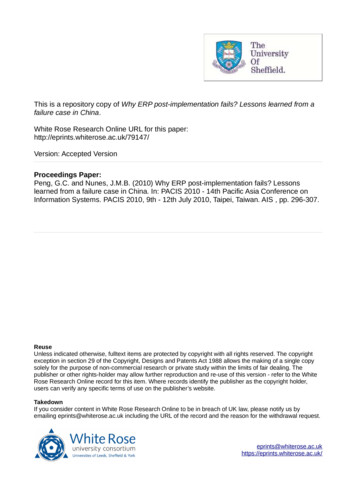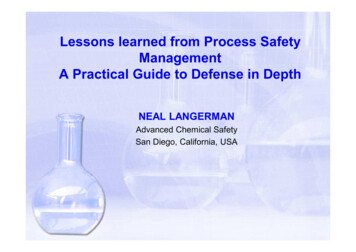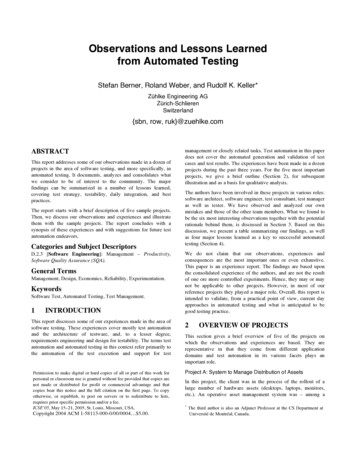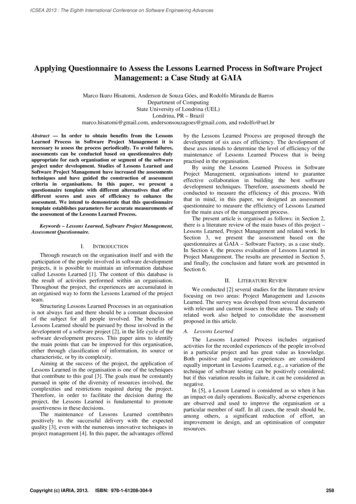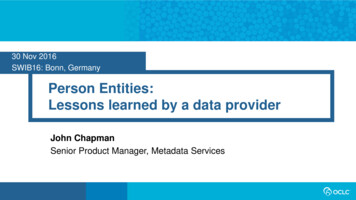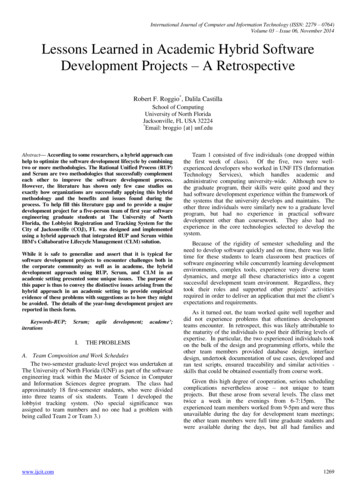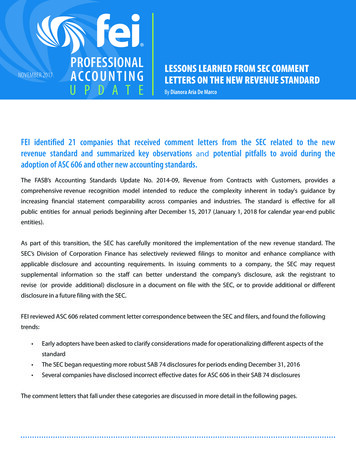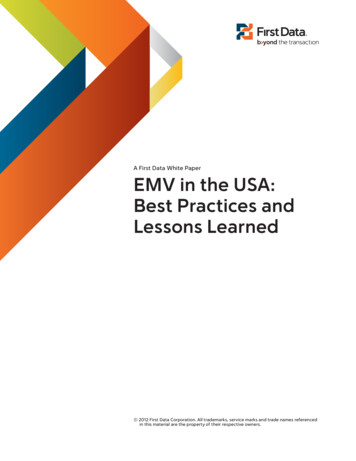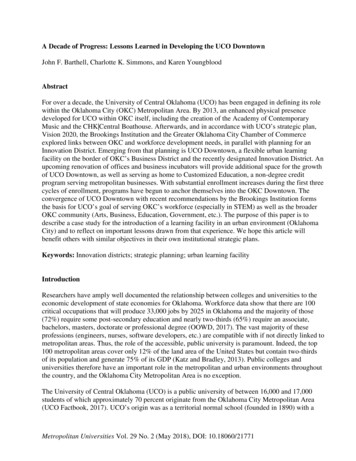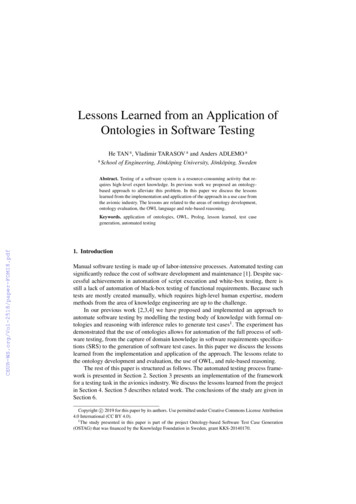
Transcription
Lessons Learned from an Application ofOntologies in Software TestingHe TAN a , Vladimir TARASOV a and Anders ADLEMO aof Engineering, Jönköping University, Jönköping, Swedena SchoolAbstract. Testing of a software system is a resource-consuming activity that requires high-level expert knowledge. In previous work we proposed an ontologybased approach to alleviate this problem. In this paper we discuss the lessonslearned from the implementation and application of the approach in a use case fromthe avionic industry. The lessons are related to the areas of ontology development,ontology evaluation, the OWL language and rule-based reasoning.Keywords. application of ontologies, OWL, Prolog, lesson learned, test casegeneration, automated testing1. IntroductionManual software testing is made up of labor-intensive processes. Automated testing cansignificantly reduce the cost of software development and maintenance [1]. Despite successful achievements in automation of script execution and white-box testing, there isstill a lack of automation of black-box testing of functional requirements. Because suchtests are mostly created manually, which requires high-level human expertise, modernmethods from the area of knowledge engineering are up to the challenge.In our previous work [2,3,4] we have proposed and implemented an approach toautomate software testing by modelling the testing body of knowledge with formal ontologies and reasoning with inference rules to generate test cases1 . The experiment hasdemonstrated that the use of ontologies allows for automation of the full process of software testing, from the capture of domain knowledge in software requirements specifications (SRS) to the generation of software test cases. In this paper we discuss the lessonslearned from the implementation and application of the approach. The lessons relate tothe ontology development and evaluation, the use of OWL, and rule-based reasoning.The rest of this paper is structured as follows. The automated testing process framework is presented in Section 2. Section 3 presents an implementation of the frameworkfor a testing task in the avionics industry. We discuss the lessons learned from the projectin Section 4. Section 5 describes related work. The conclusions of the study are given inSection 6.Copyright c 2019 for this paper by its authors. Use permitted under Creative Commons License Attribution4.0 International (CC BY 4.0).1 The study presented in this paper is part of the project Ontology-based Software Test Case Generation(OSTAG) that was financed by the Knowledge Foundation in Sweden, grant KKS-20140170.
Figure 1. A framework for automation of testing process using ontologies2. A Framework for Testing Process Automation Using OntologiesA typical process of black-box testing of functional software requirements comprises twoactivities. During the first activity, software testers design test cases based on SRS andtheir own expertise from previous work on testing software systems. The second activityis to generate test scripts. Finally, the tests are carried out, either manually or usinga test execution tool, based on the automated execution of test scripts. Fig. 1 presentsa framework to automate such a testing process using ontologies. The framework wasdeveloped in our project, OSTAG.Requirements are often described in well-structured or semi-structured textual documents. First, a requirements ontology is built, to represent the structure of the softwarerequirements. With the help of the ontology, the requirements information is extractedfrom the text documents and then used to populate the ontology. The populated ontologyserves as an input for the test case generator.In situations where the testers’ expertise is less structured, the information is acquired through interviews with experienced testers and examination of existing softwaretest description (STD) documents. The acquired testing strategies are represented withinference rules that utilize the populated requirements ontology for checking conditionsand querying data to generate test cases.Furthermore, a test case ontology is provided to specify what should be containedin test cases and how each test case should be structured. The test case ontology is usedin the test case generation step. The ontology is populated when test cases are generated.Finally, the populated test case ontology is employed to generate test scripts.3. An Implementation of the FrameworkIn this section we demonstrate an implementation of the framework. The implementationis to support testing of the components of an embedded sub-system within an avionicsystem. The case data were provided by the fighter aircraft developer, Saab Avionics.In the avionics industry, many of the systems are required to be highly safety-critical.For these systems, the software development process must comply with several industry standards, like DO178B. The requirements of the entire system, or units making upthe system, must be analyzed, specified, and validated before initiating the design andimplementation phases. The software test cases have to be manually inspected as well.The requirements and test cases that were used in the framework implementation wereprovided in text documents and the results were manually validated by avionic industrydomain experts.
3.1. Requirements Ontology and Test Case OntologyThe requirements ontology (see Fig. 2) was built by ontology experts based on the structure of the textual requirements specification documents provided by Saab Avionics.Each requirement has a unique ID and consists of at least:1. Requirement parameters, which are inputs of a requirement,2. Requirement conditions,3. Results, which are usually outputs of a requirement and exception messages.Some requirements require the system to take actions. More details about the ontologycan be found in [2].The test case ontology (see Fig. 3) was also built by ontology experts based on thestructure of test case descriptions created by the industrial partner. Each test case hasa unique ID, addresses one requirement, and has prerequisite conditions. There is a listof ordered steps needed to be followed in each test case. Each step consists of input,procedure and expected result.The ontologies were built using the ontology language OWL, and developed in thetool Protégé. The classes Test Input, Test Procedure and Test Results are defined asthe subclasses of OWLList [5], which is a representation of a sequence in OWL-DL.Figure 2. The key entities in the requirements ontologyFigure 3. The key elements in the test case ontology
Figure 4. Ontology fragment of the SRSRS4YY-431 requirement specification3.2. Population of the Requirements OntologyThe populated ontology contains 147 individuals in total in the experiment. Fig. 4shows a fragment of the populated ontology for one particular functional requirement,SRSRS4YY-431. The requirement states that if the communication type is out of its validrange, the initialization service shall deactivate the UART (Universal Asynchronous Receiver/Transmitter), and return the result “comTypeCfgError”. In Fig. 4, the rectanglesrepresent the concepts of the ontology; the rounded rectangles represent the individuals(instances); and the dashed rectangles provide the data values of datatype property forindividuals.3.3. Approach to Test Case Generation based on Inference RulesTest cases are generated through deriving information from the populated requirementsontology with the help of inference rules. A necessary task to solve to derive test casesfrom the requirements ontology is to represent testers’ expertise on how they use requirements to create test cases. Such expertise embodies inherent strategies for test case creation, knowledge that can be expressed in the form of heuristics represented as if-thenrules. This kind of knowledge is acquired from two sources. First, literature on softwaretesting contains some general guidelines, e.g. boundary value testing. These general teststrategies apply to all domains. Second, expert testers were interviewed to capture theirexpertise that is specific to particular types of software systems and/or particular domains. Such testing knowledge needs to be acquired for each domain type. Additionally,existing test cases and their corresponding requirements were examined and analysed.The details of the test case generation with inference rules are provided in [4].The condition (if-part) of a heuristic rule is formulated using the ontology instances(individuals) representing the requirement and connected hardware parts, input/output
parameters and the like. The instructions for generating a test case part are expressedin the action part (then-part) of the rule. The Prolog programming language was chosenfor coding the acquired inference rules. The requirements ontology was first translatedinto the Prolog syntax, to prepare the ontology for the inference rules. The translatedontology can be loaded as part of the Prolog program, and the ontology entities can bedirectly accessed by the Prolog code. The inference engine that is built-in into Prologwas used to execute the coded rules to generate test cases. An example of the inferencerule written in Prolog that implements the acquired test case generation heuristic rule forthe requirement SRSRS4YY-431 is given below:% construct TC procedure1tc procedure(Requirement, [Service, WriteService, ReadService,recovery(Service)]) :% check condition for calls #2-42action(Requirement, deactivateUART),% get service individual for calls #1,43service(Requirement, Service),% get individuals of the required services4type(WriteService, transmission service),5type(ReadService, reception service).% check the required action6action(Requirement, Action) :objectPropertyAssertion(requiresAction, Requirement, Action).% retrieve the service of a requirement7service(Requirement, Service) :objectPropertyAssertion(requirementForService, Requirement, Service).% check the type of an instance8type(Individual, Class) :classAssertion(Class, Individual).Line 1 in the example is the head of the rule consisting of the name, “input” argumentand “output” argument, which is the constructed procedure as a Prolog list. The list isconstructed from the retrieved ontology entities and special term functors. Line 2 encodesthe condition of the heuristic. Lines 3-5 are the queries to retrieve the relevant entitiesfrom the ontology. The predicates 6-8 are auxiliary and help perform the actual retrievalof the required entities from the ontology.Each test case is generated sequentially, from the prerequisites part to the resultspart. The generated parts are collected into one structure (Prolog term).3.4. Population of the Test Case OntologyDuring the generation phase, all created test cases are stored in the Prolog working memory as a list. When the test case list is complete, the next phase of the ontology population starts. The test cases in the list are processed consecutively. For each test case,an instance is created with object properties relating it to the addressed requirement andtest case parts. After that, instances with object properties are created for the four testcase parts: prerequisites, test inputs, test procedure and expected test results. If the partscontain several elements, OWL lists are used for the representation.There are two Prolog predicates from the ontology population layer that perform ontology population: ontology comment and ontology assertion. The former is used to insert auxiliary comments in the ontology. The latter asserts OWL axioms representing test case elements in the test case ontology. The four additional
Table 1. Test case from the STD (left column) and the corresponding generated test case by applying inferencerules to the populated requirements ontology (right column).Test Inputs1. According to table below.2. uartId : uartId from thers4yy init call3. uartId : uartId from thers4yy init call4. parity : rs4yy noneParityTest Inputs:1. parity : min value - 1, parity : max value 1, parity : 6818812. uartID : uartID from the initializationServicecall3. uartID : uartID from the initializationServicecall4. parity : noneParityTest Procedure1. Call rs4yy init2. Call rs4yy write3. Call rs4yy read4. Recovery: Call rs4yy initTest Procedure:1. Call initializationService2. Call writeService3. Call readService4. Recovery: Call initializationServiceExpected Test Results1. result rs4yy parityCfgError2. result rs4yy notInitialised3. result rs4yy notInitialised, length 04. result rs4yy okExpected Test Results:1. result parityConfigurationError2. result rs4yyNotInitialised3. result rs4yyNotInitialised, length 04. result rs4yyOk.predicates, populate w prereq, populate w inputs, populate w procedure andpopulate w results, create OWL statements for the test case parts by processing listsassociated with each part. The the name prefix and initial number of each of these predicates are passed to construct instances of an OWL list representing this test case part.Finally, the newly asserted axioms are serialized in the ontology source file by theontology serialization layer. It takes care of translating the OWL assertions from theProlog syntax into the OWL functional-style syntax with the help of a definite clausegrammar.3.5. Test Scripts GenerationIn order to carry out testing, test cases need to be transformed into executable procedures.Such procedures are usually programs written in a language like Python or C. However,our project partner, Saab Avionics, follows a strict quality assurance process. Accordingto their process, all test cases have to be thoroughly inspected as plain text by the quality assurance team before they are signed of for actual execution. For this reason, thetest cases were translated into plain English in the OSTAG project. The translation wasimplemented
Lessons Learned from an Application of Ontologies in Software Testing He TANa, Vladimir TARASOVa and Anders ADLEMOa aSchool of Engineering, Jonk oping University, J onk oping, Sweden Abstract. Testing of a software system is a resource-consuming activity that re-quires high-level expert knowledge. In previous work we proposed an ontology-Cited by: 1Publish Year: 2019Author: He Tan, Vladimir Tarasov, Anders Adlemo
